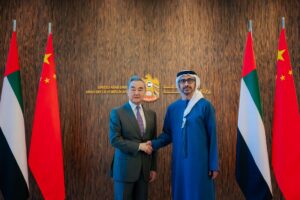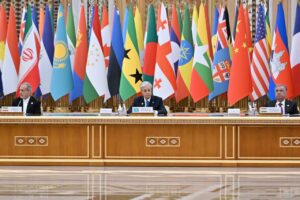Bridging Nations and Generations: A Green Vision for the BRI

San Francisco: President Xi Jinping and President Joe Biden
The recent meeting in San Francisco between President Xi Jinping of China and President Joe Biden of the United States underscored the urgent need for global collaboration on climate change.
Recognizing their roles as the world’s top carbon emitters, both leaders acknowledged the necessity of addressing environmental challenges while promoting sustainable development.
President Xi emphasized the crucial role of sustainable development as the “golden key” to solving global issues. He presented key proposals at the Asia-Pacific Economic Cooperation (APEC) Economic Leaders‘ Meeting, focusing on expediting the implementation of the UN 2030 Agenda for Sustainable Development. The introduction of the Global Development Initiative (GDI) aimed to enhance international cooperation and address development deficits, showcasing China’s commitment to inclusive growth.
President Xi proposed a new path for green development, emphasizing coordinated efforts to transform energy, industrial, and transportation structures. This involves promoting carbon and pollution reduction, green expansion, and high-quality employment to create a balanced ecosystem where economic advancement aligns with environmental sustainability. China and the United States pledged to collaborate on reducing methane emissions, supporting renewable energy growth, and addressing plastic pollution. Their commitment to tripling renewable energy capacity globally by 2030 reflects a shared responsibility for environmental stewardship, setting a positive precedent for global climate change efforts.
Despite the promising developments in international cooperation, challenges persist in aligning China’s Belt and Road Initiative (BRI) with global climate goals. The BRI’s environmental impact, especially concerning nonrenewable energy projects, has faced scrutiny. As the world approaches critical temperature thresholds, vulnerable areas with 40% of the global population face profound social, economic, and political implications. Youth, increasingly vocal about their concerns, demand action from global leaders.
The BRI, envisioning a community with a shared future, involves the younger generation in building bridges between nations. With the projected population of BRI countries reaching approximately 5.4 billion by 2030, youth involvement becomes pivotal in shaping a sustainable future. Despite challenges, the transition to a low-carbon economy in China, given its significant carbon emissions, offers opportunities for innovation and sustainable practices. China advocates for building global synergy, urging countries to uphold the United Nations Framework Convention on Climate Change.
Youth engagement is crucial in addressing climate change, and their concerns should be taken seriously by leaders worldwide. As China and the United States collaborate on environmental initiatives, the alignment of the Belt and Road Initiative with sustainable development goals becomes essential. By integrating youth perspectives, fostering international cooperation, and redefining the BRI’s focus, a path to a cleaner, more sustainable future can be forged. The upcoming COP28 serves as a crucial waypoint for global climate mitigation efforts, requiring nations to work collectively to meet the challenges ahead.
In the context of global infrastructure demands, economic fallout from COVID-19, and the imperative to address climate change, the BRI emphasizes the importance of accelerating a sustainable recovery. The Green Investment Principles, integral to the BRI’s vision, guide investments toward environmentally friendly projects, ensuring a balance between economic growth and ecological preservation. Despite some criticisms, the BRI has been conceptualized as the “Green Belt and Road,” underscoring China’s commitment to sustainability, environmental protection, and international environmental standards.
Contrary to claims of negative environmental impacts, a closer examination reveals the BRI’s dedication to preserving biodiversity, promoting clean energy, and implementing well-prepared environmental governance structures. BRI projects, such as the Peljesac bridge in Croatia, exemplify a commitment to environmental standards, dispelling concerns raised by local communities. The BRI responds to air pollution and health issues in host countries by incorporating projects that promote clean and renewable energy, including wind farms, solar power plants, and eco-friendly transportation systems. Initiatives like the Cox’s Bazar wind power project in Bangladesh showcase the BRI’s role in providing cleaner and more sustainable energy sources, reducing carbon emissions, and contributing to the global shift towards green energy.
The BRI’s commitment to environmental protection is reinforced by well-prepared environmental governance structures. The BRI Action Plan released in 2015 outlines the vision and framework, emphasizing environmental protection. Collaboration with the United Nations Environment Programme, Environmental Impact Assessment Guidelines, and the formation of the BRI International Green Development Coalition underline China’s dedication to green and sustainable development. China’s promotion of green finance within the BRI framework, including green bonds and investment practices, channels funds into environmentally friendly projects, supporting renewable energy, energy-efficient technologies, and sustainable infrastructure.
The BRI emerges not just as a geopolitical strategy but as a beacon of hope for a sustainable and shared future. By incorporating youth, adhering to Green Investment Principles, and emphasizing environmental protection, the BRI stands as a model for global cooperation in the face of climate change. As nations unite under the “Green Belt and Road,” the BRI paves the way for a resilient and environmentally conscious world.


